Solana: A Financial Bazaar in the Crypto Landscape
Grayscale, a leader in institutional cryptocurrency investment, recently labeled Solana (SOL) as “crypto’s financial bazaar” in a research note published on October 10. This assessment dives deeper than the typical narratives surrounding speed and efficiency, positioning Solana as the frontrunner in user engagement, transaction volume, and fee generation. The research suggests that Solana’s robust user experience, combined with its architectural strengths—particularly the Solana Virtual Machine—promises solid long-term value for the digital asset. Importantly, Grayscale’s shift towards recognizing Solana’s potential reflects a broader institutional interest, akin to the early perceptions that regarded Ethereum as “digital oil.”
A Noteworthy Institutional Shift
The cornerstone of Grayscale’s report isn’t merely their endorsement of Solana—it also symbolizes a significant pivot in institutional attitudes. Given Solana’s struggles in the aftermath of the FTX collapse, Grayscale’s renewed focus could signify a broader acceptance of varying blockchain solutions among traditional financial players. This paradigm shift is critical as it piques interest from other institutional desks, drawing their attention to a platform initially deemed unworthy of investment. However, the pivotal question revolves around whether the underlying data supports Grayscale’s claims, or if Solana’s characterization as a “financial bazaar” remains more metaphorical than demonstrably quantitative.
Evaluating Grayscale’s Claims
Grayscale’s report underscores three core components for Solana’s emergence as a predominant smart contract platform: user engagement, transaction volume, and revenue generation. They cite a striking figure of $425 million in monthly ecosystem fees, indicating an annualized run rate exceeding $5 billion, alongside substantial decentralized exchange (DEX) volumes exceeding $1.2 trillion. Grayscale emphasizes significant user metrics, including Pump.fun’s 2 million monthly active users and Helium’s 1.5 million daily participants, reinforcing the diversity and resilience of applications built on the Solana ecosystem.
Furthermore, Solana boasts over 1,000 dedicated developers, positioning it as the fastest-growing blockchain platform over the past two years. Notably, Solana establishes rapid transaction finality—around 12 to 13 seconds—while maintaining exceptionally low average transaction fees of approximately $0.02, contributing to a competitive landscape when compared to other blockchains. An upcoming upgrade, named Alpenglow, is poised to bring transaction finality down to as low as 100 to 150 milliseconds, enhancing Solana’s already impressive performance metrics.
The Data-Driven Reality Check
Although Grayscale’s outlook is optimistic, it is essential to scrutinize their data claims against actual metrics derived from primary on-chain data and developer analytics. Current statistics reveal Solana consistently operates with about 2.6 million active addresses, and around 67 million on-chain transactions daily—figures consistent with previous projections of user engagement. However, the reported $425 million monthly fee needs closer examination; recent data from Token Terminal suggests fees fluctuating between $30 million to $40 million monthly in the past few months, potentially overstating the consistent earnings that Grayscale posits.
While Solana’s DEX volumes are impressive—exceeding $40 billion in a week at points this year—the figure portraying ongoing fee achievement during varying market conditions seems inflated. The diversity and complexity of application-generated fees compared to baseline chain fees must be taken into account for a clearer financial picture. Grayscale’s assertion of Solana’s developer growth, while impressive, simply aligns with broader data confirming Solana as a strong player, with around 17,708 total developers as of mid-2025, reinforcing the notion of its increasing ecosystem.
Institutional Attraction to Solana
What’s igniting institutional interest in Solana? A combination of speed, cost efficiency, and predictability characterizes Solana’s user experience. Local fee markets minimize congestion during high-demand periods, ensuring everyday transactions remain affordable. With high reliability since recovering from a major mainnet outage in early 2024, Solana has significantly improved its uptime and throughput positions, making it appealing to custodians and financial venues. DeFiLlama evidence illustrates that Solana maintains a prominent position in chain-level DEX volumes, underpinning its reputation as a strong contender among blockchain networks.
Moreover, the growing liquidity across Solana’s DEX and aggregator networks—most notably through Jupiter—facilitates effective execution and financial hedging, driving further institutional interest. The recent approval of several spot SOL ETFs applications showcases a blossoming regulatory appeal, with mainstream financial issuers keenly observing market readiness, even amid some delayed timelines.
Addressing Structural Challenges
While Grayscale paints a largely positive picture of Solana’s future prospects, it is critical to acknowledge notable structural limitations and trade-offs. Centralization remains a concern, with a significant proportion of SOL tokens staked in centralized data centers, raising questions about decentralization and network security. The Nakamoto coefficient—a measure of effective decentralization—currently highlights vulnerability. A low coefficient indicates that a small number of entities could potentially obstruct transactions, raising the stakes for long-term blockchain viability.
Additionally, the annual issuance rate of SOL is notably higher than Bitcoin’s capped supply, impacting SOL’s position as a potential store of value compared to other leading cryptocurrencies. Changes in the network’s fee and burn policies weaken the deflationary effects during lower activity, further complicating Solana’s prospects as a stable long-term asset.
Conclusion: The Road Ahead for Solana
Grayscale’s analysis provides a nuanced understanding of Solana as a vibrant ecosystem with substantial user engagement and development activity. The “financial bazaar” characterization, while a potentially marketable aspect, underscores a broad yet diverse on-chain economy that seems to hold its own against leading competitors. Nonetheless, significant caveats arise—specifically regarding user fee projections and the underlying factors affecting Solana’s long-term decentralization and store-of-value potential.
Critical milestones, including the anticipated Alpenglow upgrade that will improve transaction finality and the ongoing development of a diverse client ecosystem, will be vital indicators of Solana’s ability to foster sustainable institutional interest. As the blockchain landscape continues to evolve, Solana’s capability to address its structural challenges will determine if its reputation as a "financial bazaar" can solidify into a lasting legacy in the crypto market.


